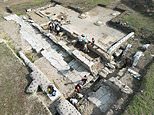
It remained abandoned for around 1,500 years, a lost relic of the Roman era.
But a forgotten town that dates back to the days of Julius Caesar has finally been uncovered in Central Italy.
Interamna Lirenas, located about halfway between Rome and Napes, was a ‘thriving’ Roman town that would have been home to 2,000 people at its peak, experts say.
Despite being mistaken by archeologists in the 1980s as merely a small settlement, it was a grand town complete with a housing, a temple, baths and a roofed theatre.
Unlike Pompeii and Herculaneum, it wasn’t destroyed by a natural disaster and was only abandoned in the 6th century AD due to the threat of invasion.
Drone view of the excavation of the two footpaths lining the street separating the basilica (top) from the theatre (bottom) at Interamna Lirenas
The site of Interamna Lirenas occupies a southern spur of a river terrace in the middle of the Liri Valley, a fundamental route of communication across Central Italy
What is Interamna Lirenas?
Interamna Lirenas is a former Roman town in Central Italy, located about 80 miles from Rome.
It was founded in 312 BC and abandoned in 6th century AD – so after the end of the Roman Empire.
Even when Italy’s decline was in full swing, Interamna Lirenas ‘continued to exist as a civic centre of some relevance’.
It’s been described as an ‘invisible town’ because its physical remains are not readily apparent.
Despite being mistaken by archeologists in the 1980s as merely a backwater, it was a grand settlement complete with a housing, a temple, baths and a roofed theatre.
The experts focused on pottery and the foundations of buildings from the excavations, as well as the results of geophysical surveys of the ground.
Excavations at the site commenced in 2010, but only now have the results been published.
The 13-year study was authored by Dr Alessandro Launaro at the University of Cambridge’s Classics Faculty.
‘Interamna Lirenas was strategically located between a river and a major road, and it was a thriving node in the regional urban network,’ he said.
‘It would have been valuable as he sought to consolidate support across Italy during the civil wars.
‘This town continually played its cards right, it was always forging relations with communities between Rome and southern Italy while thriving as a trading hub.’
Interamna Lirenas was founded in 312 BC, during the era of the Roman Republic (the era before the mighty Roman Empire).
The town gained the patronage of Roman general Julius Caesar in 46 BC, two years before his murder (which led to the formation of the Roman Empire in 27 BC).
But Interamna Lirenas was abandoned in the 6th century – around 100 years after the decline of the Empire.
According to Dr Launaro, this town managed to ‘buck the trend’ of the Empire’s decline, but exactly how is unclear.
‘We believe that local and regional networks (political, social and economic) proved very resilient and allowed life to continue,’ he told MailOnline.
Interamna Lirenas was home to a number of magnificent buildings that no longer stand, with only their foundations now visible following excavations.
Namely, a roofed theatre, built with marble imported from across the Mediterranean, measured around 150 by 85 feet and would have been big enough to seat 1,500 people.
This aerial shot shows the remains of the theatre (bottom) and a public building called a basilica (top)
Artist’s depiction of the theatre that could seat about 1,500 spectators and its roof spanned 80 feet, enough to put it in line with some of the largest roofs in the Roman world
An artist’s impression of the interior of the Interamna Lirenas theatre from the seating area, showing the scaena, the facade of the stage
Roofed theatres were quite rare in Roman Italy and would’ve been seen as a significant upgrade on open-air structures, according to Dr Launaro.
‘This theatre was a major status symbol,’ he said.
‘It displayed the town’s wealth, power and ambition.’
Next to the theatre stood a public building called a basilica, typically used for governmental or legal purposes.
The town also boasted three bath complexes, the largest of which featured a big swimming pool surrounded by a portico, a type of elaborate porch.
Much like Pompeii and Herculaneum, Interamna Lirenas shows no sign of zoning or separation by social status and was densely packed with houses of various sizes.
In all, 190 of the town’s houses (or 84 per cent) were small (less than 5,380 square feet), 25 were larger (between 5,380 and 10,700 square feet) and only five were over 10,700.
The team also found 19 ‘courtyard buildings’ which they believe may have served as indoor market buildings, guildhouses, apartment blocks and public warehouses.
The experts focused on pottery (picture) and the foundations of buildings discovered during the excavations, as well as the results of geophysical surveys of the ground
This shot from drone footage captured in September 2023 shows a stunning view of the ‘invisible town’, historically overlooked by experts
Geophysical survey results showing underground traces of Interamna Lirenas surrounded by the wider modern-day landscape
A plan of Interamna Lirenas showing the distribution of different types of buildings. Note the predominance of housing
Dr Launaro and colleagues did not find a layer of ash or any other evidence to suggest that the town was violently destroyed like Pompeii and Herculaneum.
Instead, the inhabitants probably deserted the town amid ‘growing insecurity’ over whether the region was safe, at some point in the 6th century.
The academic points to the invasion of the Germanic people known as the Lombards took place in the late 6th century AD.
The townsfolk of Interamna Lirenas because they knew they were on a direct route which Lombard armies were bound to use, he suggests.
However, the town was progressively reducing in size over the previous couple of centuries.
Dr Launaro’s study appears in the edited volume of a new book published today, called Roman Urbanism in Italy.
THE LIFE (AND HORRIFIC DEATH) OF JULIUS CAESAR
Julius Caesar was a politician and general of the late Roman republic who lived from 100 – 44 BC.
Julius Caesar was a politician and general of the late Roman republic who lived from 100 – 44 BC (artist’s impression)
As a general from 60 – 68 BC, Caesar added the whole of modern France and Belgium to the Roman empire, and crushed rebel Gallic forces across Europe in the Gallic wars.
In total he made two expeditions to Britain, in 55 BC and 54 BC, though never established a force of occupation.
Caesar returned to Italy a hero and famously crossed the Rubicon river in 49 BC without disbanding his army, insulting the authority of the Roman senate.
In the ensuing civil war Caesar defeated the republican forces, and took control of the Empire as dictator.
He used his power to carry out much-needed reform, relieving debt, enlarging the senate, building the Forum Iulium and revising the calendar.
Caesar’s ambition and success eventually led to his downfall when a group of republican senators assassinated him in 44 BC.
Julius Caesar was stabbed (23 times) to death in the Roman Senate led by Marcus Junius Brutus, Gaius Cassius Longinus and 60 other co-conspirators.
On his way to the Theatre of Pompey where he would be assassinated, the all-powerful Caesar visited a seer who had foretold that harm would come to him not later than the Ides of March.
Caesar joked, ‘The ides of March are come’, to which the seer replied ‘Ay, Caesar, but not gone.’
His wife Calpurnia had dreamed of his body streaming with blood and tried to prevent him from leaving the house.
As Caesar took his Senate seat, the conspirators gathered around him. One then took hold of his purple toga and ripped it away from his neck.
A dagger was thrust at Caesar’s throat but missed and only wounded him.
Another assassin then drove a dagger into his chest as he twisted away from the first assailant.
Brutus struck Caesar in the groin. It was later written that Brutus was reproached in Greek with the words ‘You, too, my child?’
Source link
CHECK OUT: Top Travel Destinations
READ MORE: Travel News



